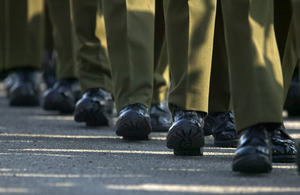Third tranche of Armed Forces redundancies announced
The Army has today announced which employment fields will be liable for tranche three of the Armed Forces Redundancy Programme.

Soldiers' boots [Picture: Graeme Main, Crown Copyright/MOD 2008]
These redundancies are not new and are the third tranche of the Armed Forces Redundancy Programme that was announced in the Strategic Defence and Security Review in October 2010, and in July 2012. This tranche will consist of up to 5,300 soldiers from the Army and will not involve any Royal Navy or Royal Air Force personnel.
The Army has worked hard to limit the numbers of soldiers involved throughout the Armed Forces Redundancy Programme by reducing recruitment levels, and has made certain groups of soldiers exempt from selection on the day that redundancy notices are issued. They are:
- soldiers that are recovering from a serious injury sustained on operations;
- soldiers preparing for combat operations, unless they voluntarily apply;
- soldiers on combat operations, unless they voluntarily apply; and
- soldiers recovering from combat operations, unless they voluntarily apply.
As a result of the drawdown plans already announced, those units liable to deploy on Operation Herrick 19 will not be confirmed until April 2013.
Personnel who are liable to deploy with their units to Afghanistan in Autumn 2013 on the day the redundancy notices are issued will be exempt from Tranche 3 unless they are an applicant.
Defence Secretary Philip Hammond said:
The Army is actively managing recruitment to reach the target numbers, but unfortunately redundancies are unavoidable due to the size of the defence deficit that this government inherited and the consequent scale of downsizing required in the Army.
We will have smaller Armed Forces but they will in future be properly equipped and well-funded, unlike before. These redundancies will not affect current operations in Afghanistan, where our Armed Forces continue to fight so bravely on this country’s behalf.
The Army has a robust resettlement programme in place and historically 93 per cent of those who look for work are in full-time employment within 6 months of leaving, rising to 97 per cent after 12 months.
91 per cent of Tranche 1 applicants who left the Armed Forces in March or April 2012 have already found alternative employment after 6 months.
Chief of the General Staff General Sir Peter Wall said:
The Army is unfortunately reducing to 82,000 by 2020 and this tranche of redundancy is essential to achieving that. I fully recognise the unwelcome uncertainty and pressure for those who will be liable in the employment fields announced today.
For some it may present an opportunity; for others it will curtail their service prematurely. Our aim now is to apply the process as fairly as possible and to prepare to support those individuals who are selected as they and their families transition to civilian life.
There is likely to be a need for a further tranche for Army personnel and medical and dental personnel from the Royal Navy and Royal Air Force.
To ensure any further redundancies are as fair as possible it is likely that they will include soldiers who were exempt from redundancy in Tranche 3 due to operational exclusions. This work is ongoing.
It is important that the Armed Forces continue to recruit to ensure we have enough quality junior ranks and young officers to promote up through the organisation in future.
The Armed Forces Redundancy Programme has been designed to safeguard those skill sets needed in the future Armed Forces, while ensuring that rank structure remains balanced and support to combat operations is not compromised.